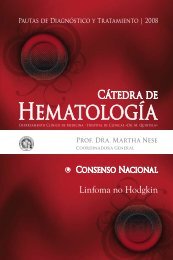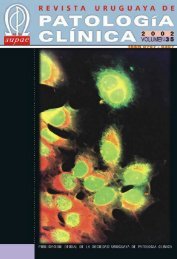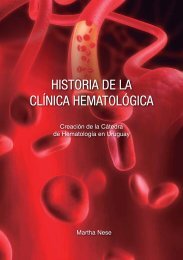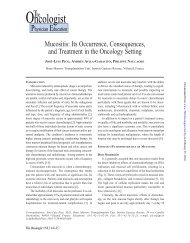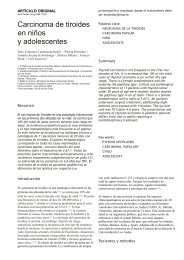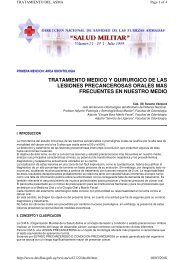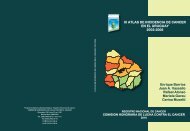2040 CANCER June 1, 2001 / Volume 91 / Number 11cells in mitosis <strong>and</strong> interphase indicated that the limitedactivity <strong>of</strong> estramustine <strong>and</strong> <strong>paclitaxel</strong> as singleagents could become synergistic against <strong>and</strong>rogen independentprostate carcinoma cells. 14 When 96-hourinfusions <strong>of</strong> <strong>paclitaxel</strong> at 120 mg/m 2 every 21 <strong>days</strong>were given with continuous <strong>oral</strong> estramustine at 600mg/m 2 for 21 <strong>days</strong> in patients with hormone-refractoryprostate carcinoma, Hudes et al. 15 observed adecline in the level <strong>of</strong> serum prostate specific antigen(PSA) 50% in 53% <strong>of</strong> patients <strong>and</strong> measurable diseaseresponses in 44% <strong>of</strong> patients lasting a median <strong>of</strong>22 weeks. The spectrum <strong>of</strong> toxicity included 21% <strong>of</strong>patients with Grade 3 <strong>and</strong> 4 granulocytopenia <strong>and</strong>neuropathy attributed primarily to <strong>paclitaxel</strong> <strong>and</strong> 10%<strong>of</strong> patients with serious gastrointestinal <strong>and</strong> thromboticcomplications attributed primarily to estramustine.A similar spectrum <strong>of</strong> toxicity <strong>and</strong> response rateswere described by Petrylak et al. 7 with one infusion <strong>of</strong>docetaxel at 75 mg/m 2 <strong>and</strong> 5 <strong>days</strong> <strong>of</strong> estramustine at840 mg every 21 <strong>days</strong>.To improve on these regimens, it became a priorityto decrease toxicity <strong>and</strong> maintain or improve responserates. One approach was to modify the frequency,<strong>dose</strong>, <strong>and</strong> length <strong>of</strong> administration <strong>of</strong> eachdrug. Preclinical data 16 <strong>and</strong> clinical data 17,18 supportedthat <strong>weekly</strong> 1-hour infusions <strong>of</strong> <strong>paclitaxel</strong> 100 mg/m 2 could be as effective as <strong>high</strong>er <strong>dose</strong>s atinducing tumor cell death <strong>and</strong> clinical response withsubstantially less side effects. New information concerningan intermittent schedule <strong>of</strong> estramustine becameavailable when the results <strong>of</strong> a <strong>Phase</strong> I <strong>study</strong> 19 <strong>of</strong>3 <strong>days</strong> <strong>of</strong> <strong>oral</strong> estramustine at 900 mg/m 2 or 1200mg/m 2 <strong>and</strong> 3-hour infusions <strong>of</strong> <strong>paclitaxel</strong> at 100mg/m 2 or <strong>high</strong>er every 21 <strong>days</strong> were analyzed. In this<strong>study</strong>, gastrointestinal side effects were reduced,whereas clinical responses were observed in 4 <strong>of</strong> 15<strong>and</strong> in 6 <strong>of</strong> 14 heavily pretreated women with refractorybreast <strong>and</strong> ovarian carcinoma, respectively.These studies gave backing to a <strong>Phase</strong> I–<strong>II</strong> clinicaltrial to assess the maximum tolerated <strong>dose</strong> (MTD)safety <strong>and</strong> efficacy <strong>of</strong> <strong>weekly</strong>, 1-hour infusions <strong>of</strong> escalating<strong>dose</strong>s <strong>of</strong> <strong>paclitaxel</strong> <strong>and</strong> a brief, intermittentschedule <strong>of</strong> <strong>oral</strong> estramustine in patients with hormonerefractory prostate carcinoma.MATERIALS AND METHODSStudy DesignTo determine the MTD, safety, <strong>and</strong> efficacy <strong>of</strong> <strong>paclitaxel</strong><strong>and</strong> estramustine in this modified schedule, weused a <strong>Phase</strong> I–<strong>II</strong> design. The initial plan was to havea maximum <strong>of</strong> six cohorts <strong>of</strong> three patients. Eachcohort would be treated with an incremental <strong>dose</strong> <strong>of</strong><strong>paclitaxel</strong> starting at 40 mg/m 2 . Oral estramustine initiallywas planned to be given at 600 mg/m 2 based onthe existing experience with this <strong>dose</strong>. However, soonafter the first cohort <strong>of</strong> patients had been enrolled, theresults <strong>of</strong> our <strong>Phase</strong> I <strong>study</strong> 19 became available, suggestingthat 900 mg/m 2 may be required for activity <strong>of</strong>estramustine on a brief, intermittent schedule. Therefore,the protocol was amended to increase the <strong>dose</strong> <strong>of</strong>estramustine to 900 mg/m 2 from Cohort <strong>II</strong> onward.Each cohort would receive a minimum <strong>of</strong> 12 consecutiveweeks <strong>of</strong> therapy with a break on Week 7. Thecohort would be exp<strong>and</strong>ed by three additional patientsat the same <strong>paclitaxel</strong> <strong>dose</strong> level if one patientdeveloped Grade 3 or 4 toxicity. The MTD would bereached if two patients in a given cohort experiencedGrade 3 or 4 toxicity. At this point, no further <strong>dose</strong>escalation would be allowed.Patient SelectionEligible patients had a histologic diagnosis <strong>of</strong> adenocarcinoma<strong>of</strong> the prostate with progressive systemicdisease despite at least two endocrine manipulations.One <strong>of</strong> the manipulations included either orchiectomy,a luteinizing hormone-releasing hormone(LHRH) analogue with or without anti<strong>and</strong>rogens,megesterol acetate, or diethylstilbestrol. For patientson an anti<strong>and</strong>rogen, discontinuation <strong>of</strong> the agent wasrequired as a second hormonal manipulation for aminimum <strong>of</strong> 4 weeks with evidence <strong>of</strong> subsequentrising PSA level or progressive, measurable disease.Patients were required to have a minimum life expectancy<strong>of</strong> 3 months <strong>and</strong> an Eastern Cooperative OncologyGroup performance score 2. Additional requirementswere adequate hepatic <strong>and</strong> renal function,granulocyte count 1500/L <strong>and</strong> platelet count 100,000/L. Patients were required to be at least 3weeks beyond surgery, recovered from infectious process,<strong>and</strong> have no significant active medical illnessthat would preclude protocol treatment or survival.Prior radiation to a symptomatic metastatic site thatwas not the only measurable or evaluable lesion wasallowed. Radiation therapy <strong>and</strong> corticosteroids had tobe completed at least 2 weeks before therapy. Hydronephrosiswith impaired renal function had to be adequatelydecompressed. Patients with central nervoussystem metastasis, unstable angina, uncontrolled congestiveheart failure, or arrhythmia were excluded. Allpatients were required to sign informed consent inaccordance with institutional, state, <strong>and</strong> federal guidelines.Evaluation CriteriaA complete history <strong>and</strong> physical examination withcomplete blood count, serum chemistry pr<strong>of</strong>ile, <strong>and</strong>PSA level were performed at baseline, in Week 7, <strong>and</strong>in Week 13. Radionuclide bone scans <strong>and</strong>, computed
Weekly Paclitaxel/Estramustine in HRPC/Ferrari et al. 2041tomography (CT) scans <strong>of</strong> the abdomen <strong>and</strong> pelviswere required at baseline <strong>and</strong> at the end <strong>of</strong> the <strong>study</strong>or as indicated by biochemical or clinical progression.Clinical evidence <strong>of</strong> toxicity <strong>and</strong> complete bloodcounts were assessed <strong>weekly</strong>.Treatment ProgramTherapy was administered in the outpatient setting.All patients continued on a LHRH agonist. Paclitaxelwas given as a <strong>weekly</strong> 1-hour intravenous infusion fortwo cycle <strong>of</strong> 6 weeks, with a break on Week 7. The <strong>dose</strong>escalations <strong>of</strong> <strong>paclitaxel</strong> planned for each cohort were40 mg/m 2 , 60 mg/m 2 , 75 mg/m 2 , 90 mg/m 2 , 100 mg/m 2 ,<strong>and</strong> 110 mg/m 2 . Two <strong>days</strong> preceding the <strong>paclitaxel</strong>infusion, patients began a 3-day course <strong>of</strong> <strong>oral</strong> estramustinegiven in three divided <strong>dose</strong>s 1 hour before or2 hours after meals. The <strong>dose</strong> <strong>of</strong> estramustine was 600mg/m 2 per day for patients in Cohort I; however,starting with Cohort <strong>II</strong>, it was raised to 900 mg/m 2 perday in an attempt to decrease toxicity <strong>and</strong> maintainefficacy. One hour before <strong>paclitaxel</strong> infusion, patientsreceived intravenous diphenhydramine 50 mg, ranitidine50 mg, <strong>and</strong> dexamethasone 20 mg, which wasreduced subsequently to 8 mg if no reactions wereobserved. At the discretion <strong>of</strong> the treating physician,responding patients were <strong>of</strong>fered an opportunity tocontinue on the same regimen after the <strong>study</strong> period.Toxicity <strong>and</strong> Response CriteriaToxicity was graded according to the revised NationalCancer Institute common toxicity criteria. Efficacy was20 –22assessed by changes in PSA levels, changes inmeasurable disease (assessed by CT scans <strong>of</strong> the abdomen<strong>and</strong> pelvis <strong>and</strong> chest X-rays), <strong>and</strong> changes inevaluable disease (assessed on bone scans). A completebiochemical response was defined as normalization<strong>of</strong> PSA levels ( 4.0 ng/mL), a partial responsewas defined as a decline in PSA levels 50% frombaseline values, <strong>and</strong> disease progression was definedas rising PSA levels 50% above baseline values. Stabledisease was defined as PSA changes that did not meetthe criteria for partial response or disease progression.PSA responses required confirmation on a second determinationat least 2 weeks apart. Measurable diseasewas assessed in bidimensionally measurable lesionswith clearly defined margins by imaging X-rays <strong>and</strong>scans. A complete response was defined as the resolution<strong>of</strong> all measurable masses <strong>and</strong> the absence <strong>of</strong>any lesions or anomalies, a partial response was definedas a reduction 50%, <strong>and</strong> a minor response wasdefined as a reduction between 25% <strong>and</strong> 50% in themeasurable lesions.The duration <strong>of</strong> response 23 was calculated fromthe date <strong>of</strong> PSA decline 50% from the initiation <strong>of</strong>TABLE 1Patient CharacteristicsCharacteristicNo. eligible patients 18No. evaluable 18RaceAfrican American 8Caucasian 8Others 2Median age in yrs (range) 69 (44–76)ECOG performance status0 171 12 0Sites <strong>of</strong> metastasesBone only 15Bone <strong>and</strong> s<strong>of</strong>t tissue 3Median baseline PSA (range) 111 (38–2853)Median no. <strong>of</strong> hormonal therapies (range) 2 (2–4)Prior chemotherapy (%) 3 (16.7)Prior radiotherapy (%) 11 (61.1)ECOG: Eastern Cooperative Oncology Group; PSA: prostate specific antigen.treatment to the date <strong>of</strong> 50% increase above the nadirPSA value or an increase 25% in the smallest sum <strong>of</strong>all tumor measurements obtained during the best response.Response was analyzed on an intent-to-treatbasis for all patients enrolled in the <strong>study</strong> <strong>and</strong> forthose in Cohorts <strong>II</strong>–IV who received the same <strong>high</strong><strong>dose</strong> <strong>of</strong> estramustine.RESULTSPatient CharacteristicsThe pretreatment characteristics <strong>of</strong> the 18 patients arelisted in Table 1. The median age was 69 years (range,44 –76 years). There were eight African-American patients,eight Caucasian patients, <strong>and</strong> two Hispanic patients.Seventeen patients had a performance status <strong>of</strong>0, <strong>and</strong> only 1 had a performance status <strong>of</strong> 1. Themedian baseline PSA level was 111 ng/mL (range,38 –2853 ng/mL). Eighteen patients had bony metastasis,<strong>and</strong> 3 had pelvic lymph node enlargement. Nonehad parenchymal organ involvement. At <strong>study</strong> entry,all patients had evidence <strong>of</strong> disease progression byrising PSA levels after two hormonal manipulationsthat included anti<strong>and</strong>rogen withdrawal for 4 – 6 weeks.Three patients had received prior chemotherapy, <strong>and</strong>11 patients had received radiation to a metastatic site.Patient Distribution Among CohortsThe three patients in Cohort I were enrolled to receive<strong>paclitaxel</strong> 40 mg/m 2 <strong>and</strong> estramustine 600 mg/m 2 . Allpatients completed two cycles <strong>of</strong> therapy. In Cohort <strong>II</strong>,three patients were enrolled to receive <strong>paclitaxel</strong> 60No.



